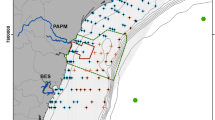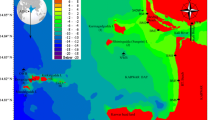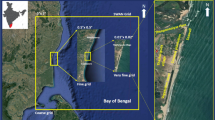Abstract
This study investigates impacts of a wave farm on waves, currents and coastal morphology adjacent to the wave farm, which is located in the Southwest of England (the Wave Hub). In this study, we focus on the interaction between waves and tides due to the presence of the wave farm and its effects on wave radiation stresses, bottom shear stresses and consequently on the sediment transport and the coast adjacent to the wave farm, using an integrated numerical modelling system. The modelling system consists of the near-shore wave model SWAN, the ocean circulation model ROMS and a sediment transport model for morphological evolution. The results show that tidal elevation and tidal currents can have a significant effect on waves and that tidal forcing and waves have a significant effect on bottom shear stresses. Waves can impact on the processes related to the bottom boundary layer and mixing intensity in the water column. The wave farm has an impact on the gradients of radiation shear stresses and bottom shear stresses that modify current speeds and wave heights, which in turn impact on the near-shore sediment transport and the resulting morphological changes. Bed load transport rates show a decrease when the wave farm is present, even during storm conditions. The results highlight the importance of the interactions between waves and tides when modelling coastal morphology with presence of wave energy devices.















Similar content being viewed by others
References
Babarit, A., and Hals J. 2011. On the maximum and actual capture width ratio of wave energy converters. Proceedings: European Wave and Tidal Energy Conference.
Beels, C., P. Troch, K. De Visch, J.P. Kofoed, and G. De Backer. 2010. Application of the time-dependent mild-slope equations for the simulation of wake effects in the lee of a farm of wave dragon wave energy converters. Journal of Renewable Energy 35: 1644–1661.
Booij, N., R.C. Ris, and L.H. Holthuijsen. 1999. A third generation wave model for coastal regions, part I, model description and validation. Journal of Geophysical Research 104(C4): 7649–7666.
Bowen, A.J. 1969. The generation of long-shore currents on a plane beach. Journal of Marine Research 27: 206–214.
Buscombe, D.D., and T.M. Scott. 2008. The coastal geomorphology of north Cornwall, Wave Hub impact on seabed and shoreline processes—report. http://www.perc.plymouth.ac.uk/whissp/nat_var.html.
Egbert, G.D., and S.Y. Erofeeva. 2002. Efficient inverse modeling of barotropic ocean tides. Journal of Atmospheric and Oceanic Technology 19: 183–204.
Gonzalez-Santamaria, R., Q. Zou, S. Pan, R., Padilla. 2010. Modelling wave-tide interactions at a wave farm in the southwest of England. Proceedings International Conference on Coastal Engineering.
Gonzalez-Santamaria, R., Q. Zou, S. Pan. 2011. Two-way coupled wave and tide modelling of a wave farm. Journal of Coastal Research, SI 64, 1038–1042, ISSN 0749–0208.
Grant, W.D., and O.S. Madsen. 1979. Combined wave and current interaction with a rough bottom. Journal of Geophysical Research 84(C4): 1797–1808.
Longuet-Higgins, M.S., and R.W. Stewart. 1962. Radiation stress and mass transport in gravity waves, with application to ‘surf beats’. Journal of Fluid Mechanics 13(4): 481–504.
Millar, D.L., H.C.M. Smith, and D.E. Reeve. 2007. Modelling analysis of the sensitive of shoreline change to a wave farm. Ocean Engineering 34: 884–901.
Monk, K.U., Q.-P. Zou, and D.C. Conley. 2013. An approximate solution for the wave energy shadow in the lee of an array of overtopping type wave energy converters. Journal of Coastal Engineering 73: 115–132.
Mulligan, R.P., A.E. Hay, and A.J. Bowen. 2008. Wave-driven circulation in a coastal bay during the landfall of a hurricane. Journal of Geophysical Research 113, C05026. doi:10.1029/2007JC004500.
Padman, L., and S. Erofeeva. 2004. A barotropic inverse tidal model for the Arctic Ocean. Geophysical Research Letters 31(2).
Roelvink, D., and A. Reniers. 2012. A guide to modelling coastal morphology. Advances in coastal and ocean engineering, vol. 12, World Scientific, pp 274.
Soulsby, R.L., and J.S. Damgaard. 2005. Bed-load sediment transport in coastal waters. Coastal Engineering 52(8): 673–689.
South West of England Development Agency (SWRDA). 2006. Wave Hub development and design phase, SWRDA Group Limited, coastal processes study report. http://www.wavehub.co.uk/.
Styles, R., and S.M. Glenn. 2000. Modeling stratified wave and current bottom boundary layers on the continental shelf. Journal of Geophysical Research 105(C10): 24119–24139.
Warner, J.C., C.R. Sherwood, R.P. Signell, C.K. Harris, and H.G. Arango. 2008. Development of a three dimensional, regional, coupled wave, current, and sediment transport model. Computers and Geosciences 34: 1284–1306.
Wiberg, P.L., and C.K. Harris. 1994. Ripple geometry in wave dominated environments. Journal of Geophysical Research 99(C1): 775–789.
Zou, Q.P. 2004. A simple model for random wave bottom friction and dissipation. Journal of Physical Oceanography 34(6): 1459–1467.
Acknowledgments
The first author thanks the National Council of Science and Technology of Mexico (CONACYT-MEXICO) for the funding and support of this research. The authors acknowledge the Southwest Regional Development Agency, UK; and the Southwest Strategic Regional Coastal Monitoring Programme, UK. The second author would like to acknowledge the support of the start-up fund provided by the University of Maine.
Author information
Authors and Affiliations
Corresponding author
Rights and permissions
About this article
Cite this article
Gonzalez-Santamaria, R., Zou, QP. & Pan, S. Impacts of a Wave Farm on Waves, Currents and Coastal Morphology in South West England. Estuaries and Coasts 38 (Suppl 1), 159–172 (2015). https://doi.org/10.1007/s12237-013-9634-z
Received:
Revised:
Accepted:
Published:
Issue Date:
DOI: https://doi.org/10.1007/s12237-013-9634-z




